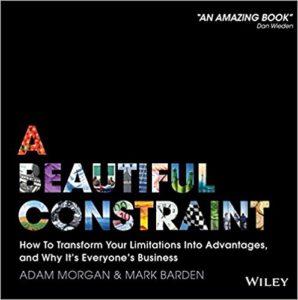If only we had more ______________________ then we could ________________________.
If we had more funds then we could do more ministry. If we had more volunteers/leaders then we could have greater capacity. If we had more time then we could increase effectiveness.

Sooner or later we all face constraints. These constraints are often circumstances beyond control and it’s easy to feel like we are stuck or a helpless victim.
In A Beautiful Constraint, Adam Morgan and Mark Barden share story after story demonstrating that constraints can actually be leveraged to launch people and organizations into amazing breakthroughs. Here are two examples:
- In the 1970s Southwest Airlines wanted to keep their four routes but they had to sell one of their four planes. Four routes with three planes seemed impossible against the constraint of time. However, this constraint sparked creativity and collaboration that introduced several innovations. Southwest dramatically reduced flight turnaround time and went on to break service and profit records.
- In 2006 Audi of America needed to find a way to win the famous 24-hour Le Mans Circuit with the constraint that their car could go no faster than the other cars. Thinking outside the box, they introduced diesel technology and saved so much time from fewer pit stops that they won the race three years straight.
Surprisingly, these stories demonstrate that constraints can actually be helpful. Creativity, thinking outside the box, reframing problems, innovation, renewed focus and collaboration are all positives that can flow from constraints.
If you are a Christian leader lamenting a constraint, could it be possible that your limitation could actually be helpful, beneficial and even…beautiful? Here are five application questions to consider:
- Could there be a bigger priority that God wants you to address? Sometimes God can use constraints in hopes of focusing us on priority issues we need to address before we are ready or able to receive more provision.
- How could you reframe your thinking about your constraint? What would happen if you moved from “we can’t because…” to “what if…” thinking? What’s the question that frames your goal in light of your constraint? Is there opportunity in this constraint?
- Who could you engage or learn from to help you think outside the box of your constraint and circumstances?
- How can your constraint or weakness actually be an opportunity for God to demonstrate his sufficiency and for you to depend on him in a deeper way? (2 Cor. 12:9)
- How does prayer fit into your constraint? Prayer helps break our self-sufficiency and brings us and our limitations to Jehovah-Jireh – the Lord who provides.
Remember Jesus telling the disciples to throw their fishing net on the other side of the boat after catching no fish all night? John 21:6 says, “When they did, they were unable to haul the net in because of the large number of fish.” A great reminder that Jesus can see and do things we can’t.
May God bring beauty into your constraints,

President, Arrow Leadership



